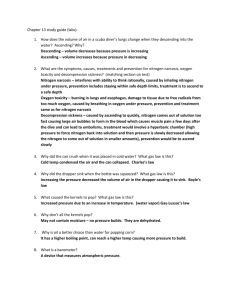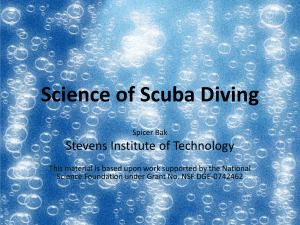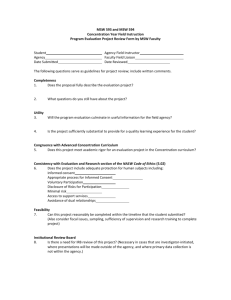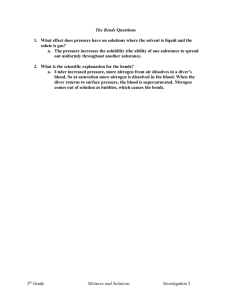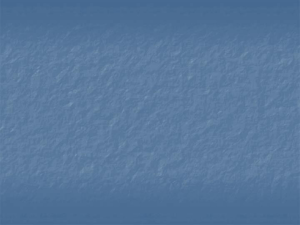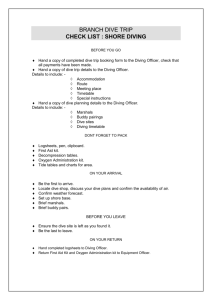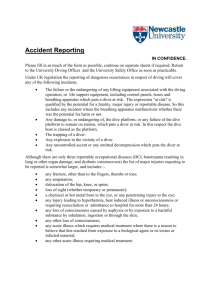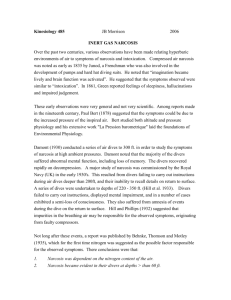Evaluation of the alleged reduced narcosis of nitrox mixtures
advertisement
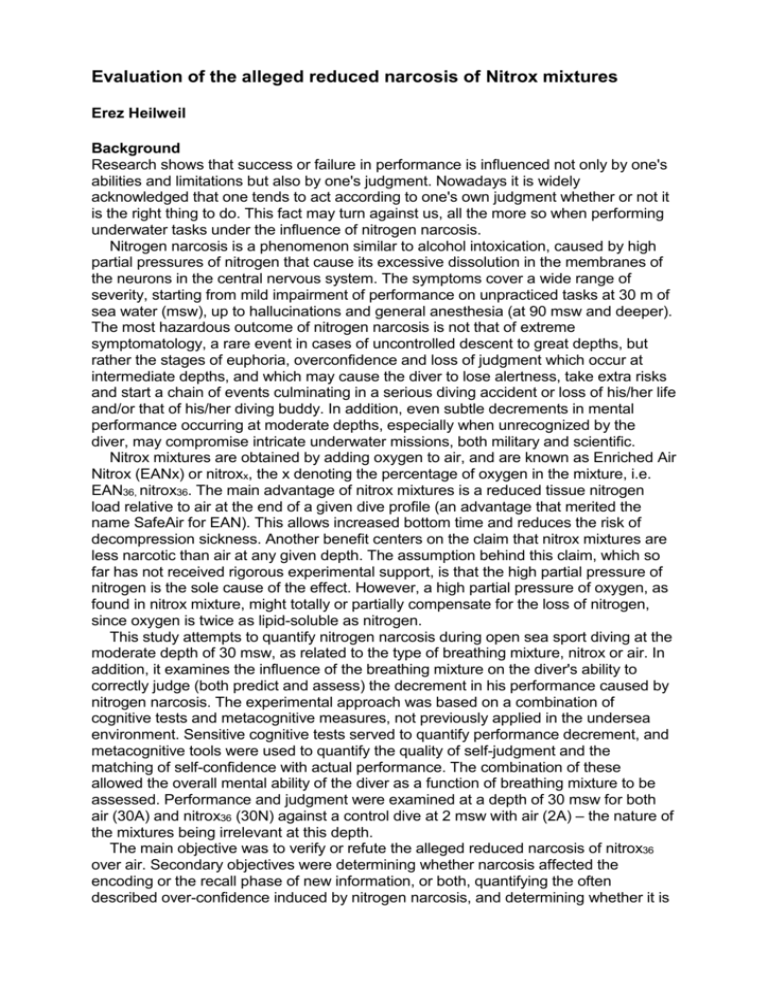
Evaluation of the alleged reduced narcosis of Nitrox mixtures Erez Heilweil Background Research shows that success or failure in performance is influenced not only by one's abilities and limitations but also by one's judgment. Nowadays it is widely acknowledged that one tends to act according to one's own judgment whether or not it is the right thing to do. This fact may turn against us, all the more so when performing underwater tasks under the influence of nitrogen narcosis. Nitrogen narcosis is a phenomenon similar to alcohol intoxication, caused by high partial pressures of nitrogen that cause its excessive dissolution in the membranes of the neurons in the central nervous system. The symptoms cover a wide range of severity, starting from mild impairment of performance on unpracticed tasks at 30 m of sea water (msw), up to hallucinations and general anesthesia (at 90 msw and deeper). The most hazardous outcome of nitrogen narcosis is not that of extreme symptomatology, a rare event in cases of uncontrolled descent to great depths, but rather the stages of euphoria, overconfidence and loss of judgment which occur at intermediate depths, and which may cause the diver to lose alertness, take extra risks and start a chain of events culminating in a serious diving accident or loss of his/her life and/or that of his/her diving buddy. In addition, even subtle decrements in mental performance occurring at moderate depths, especially when unrecognized by the diver, may compromise intricate underwater missions, both military and scientific. Nitrox mixtures are obtained by adding oxygen to air, and are known as Enriched Air Nitrox (EANx) or nitroxx, the x denoting the percentage of oxygen in the mixture, i.e. EAN36, nitrox36. The main advantage of nitrox mixtures is a reduced tissue nitrogen load relative to air at the end of a given dive profile (an advantage that merited the name SafeAir for EAN). This allows increased bottom time and reduces the risk of decompression sickness. Another benefit centers on the claim that nitrox mixtures are less narcotic than air at any given depth. The assumption behind this claim, which so far has not received rigorous experimental support, is that the high partial pressure of nitrogen is the sole cause of the effect. However, a high partial pressure of oxygen, as found in nitrox mixture, might totally or partially compensate for the loss of nitrogen, since oxygen is twice as lipid-soluble as nitrogen. This study attempts to quantify nitrogen narcosis during open sea sport diving at the moderate depth of 30 msw, as related to the type of breathing mixture, nitrox or air. In addition, it examines the influence of the breathing mixture on the diver's ability to correctly judge (both predict and assess) the decrement in his performance caused by nitrogen narcosis. The experimental approach was based on a combination of cognitive tests and metacognitive measures, not previously applied in the undersea environment. Sensitive cognitive tests served to quantify performance decrement, and metacognitive tools were used to quantify the quality of self-judgment and the matching of self-confidence with actual performance. The combination of these allowed the overall mental ability of the diver as a function of breathing mixture to be assessed. Performance and judgment were examined at a depth of 30 msw for both air (30A) and nitrox36 (30N) against a control dive at 2 msw with air (2A) – the nature of the mixtures being irrelevant at this depth. The main objective was to verify or refute the alleged reduced narcosis of nitrox36 over air. Secondary objectives were determining whether narcosis affected the encoding or the recall phase of new information, or both, quantifying the often described over-confidence induced by nitrogen narcosis, and determining whether it is affected by the breathing mixture, and finally, examining the consistency over time of nitrogen narcosis effects on the individual diver. This research was approved by the Ethics Committee of the University of Haifa (Helsinki Committee). Methodology The experiments were carried out at the Israeli Maritime College in Mikhmoret, at two flat-bottomed seabed locations chosen to provide the desired depths. The marina enabled the 2 msw (shallow control) dives, and a buoy anchored 2.4 km off shore marked the site of the 30 msw dives (deep test dives). Equipment: The equipment consisted of personal diving gear, nitrox-compatible single hose scuba regulators, nitrox-marked cylinders filled with air or nitrox36 (the contents of which were only known to the diving officers), safety equipment including a nitrox50 cylinder attached to a safety-stop platform at 5 m depth, a pure oxygen cylinder and a diving flag on board the boat, a laptop, polyester A4 paper (DFDM100), rough Teflon writing slates, pencils, carrying crates, a timekeeping slate and an underwater horn. Transportation to the offshore dive site was by speedboat, which was also used as a gearing up platform and a safety boat. Participants and experimenters: The participants in this experiment were 35 divers, 23 male and 12 female, between the ages of 20 and 30, with a diving history range of 13 to 44 dives. All were Hebrew-speaking undergraduate students at the Israeli Maritime College in Mikhmoret, who were paid per dive for participating in the experiment. All signed a consent form and a medical declaration, and presented a diving certificate and updated insurance. Due the tight schedule and study constraints, not all 35 participants completed all scheduled dives (as detailed below). This study was managed by a team of experimenters headed by the experiment manager. Task allocations were as follows. The Experiment Manager was in charge of constructing the questionnaires, monitoring the diving schedule (depth, questionnaire). The Diving Supervisor was in charge of filling the cylinders, checking the dive mixtures, providing diving equipment and keeping track of safety issues. The Timekeeper was in charge of timing the phases of the experiment, as well as being the safety diver. The Tester was an advanced diver (dive master or scuba instructor), whose role was to act as a dive buddy to the participant, carry, hand out and collect the questionnaires; The Skipper was in charge of the boat and the safety swimmer. Experiment design: The experiments were double-blind (neither the participants nor the testers knew the nature of the deep gas mixture); therefore, no-decompression limits were calculated for air, causing bottom time not to exceed 20 minutes. The experiment was of a self-control type, each diver making two 30 msw dives, one for each mixture, and a 2 msw dive which controlled the effect of submergence per se. Dive order assignments were balanced by a Latin square. Tests: In each of the three dives, three kinds of memory tests were given to the participants (a different version in each dive). Each test consisted of two phases: encoding phase and recall phase. Twenty-three divers completed the 'Faces Test' (Experiment 1), designed to assess depth effects on retrieval of visual episodic memory. The encoding phase was performed on land, where divers were required to memorize 30 faces in a fixed time, and for each one, note their level of assurance in their ability to recall it underwater, when presented together with three unknown faces. The assessment was a value between 25% (guessing) to 100% (absolute certainty). This assessment is a metacognitive measure, known as judgment of learning (JOL). After reaching the sea bottom, the recall phase began, in which participants were asked to identify the memorized face among three unfamiliar faces, and for each one, note their degree of confidence (25%-100%) in the correctness of their answer. This assessment too is a metacognitive measure, known as confidence. The 'Word-pair Test' (Experiment 2) was performed by 26 divers. Its purpose was to assess both encoding and recall of textual episodic memory underwater. In the encoding phase, divers were exposed for a fixed time to a list of 50 word pairs which they were instructed to memorize for free recall of the second word (rather than choosing it from a list of 4) when presented with the first. JOL was given, on a scale of 0%-100%. The recall phase was not followed by a confidence judgment, as the time delay from the JOL was deemed too short. The 'Picture Test' (Experiment 3) was intended to test the effect of depth/narcosis on the encoding phase of visual episodic memory by exposing the diver to a picture underwater (plus a single overall JOL score), and then asking him/her to recall details from it when back on shore, through multiple-choice questions with confidence option (on a scale of 25-100%). The results were later revealed to be biased due to technical problems, and therefore this experiment was cancelled. The JOL and the confidence are metacognitive measures from which we can derive the calibration and the resolution of the participants. Calibration is a crude estimate of the match between judgment (either JOL or confidence) and actual performance of the participant, calculated by subtracting the correct score (%) from the JOL or confidence (a negative score is defined as under- confidence, a positive score means overconfidence and zero means perfect judgment/evaluation). Resolution measures the ability of the participant to correctly recognize the questions on which he/she is more likely to err, or on which he/she actually erred. It does so by two indices: discrimination index and gamma correlation. The former, with a range of -100 to +100, is the difference between the mean (JOL or confidence) score given to questions with correct answers, and that of questions with wrong answers. Gamma correlation, ranging between -1 and +1, is a finer test, taking account of the scores given to each individual question. Experimental protocol: The experimental procedure began with the encoding phase of the Faces Test (Experiment 1), followed by equipment organization, gearing up and diving to the sea floor (2 msw or 30 msw). This process took between 40 to 60 minutes. The recall process of Experiment 1 took 2 minutes, followed by the encoding of Experiment 2, and after 30 seconds, the recall phase of Experiment 2. Experiment 3 started immediately after Experiment 2 by a 30 seconds encoding of the picture. Half an hour later, after reaching the shore, the recall phase of Experiment 3 was executed. This procedure was performed three times per participant, once for each of the conditions (2A, 30A and 30N), spaced by a period of 1 to 42 days Main results Experiment 1 showed a striking resemblance between all three dives. Depth did not affect recall performance or confidence, and obviously, there was no effect of the breathing mixture. Group mean JOL and confidence gave near-perfect calibration, demonstrating neither under- nor over- confidence. In contrast, Experiment 2 demonstrated a clear decrease in performance at depth. This decrease was not accompanied by a lower JOL, resulting in a positive mean group calibration value, indicating over-confidence. There were no significant differences between nitrox and air. There was a significant positive correlation between individual cognitive performances, as well as in the metacognitive measures between experiments, and for the two deep dives of Experiment 2. Discussion Depth effects: The results prove that even at the shallow depth of 30 msw, the Word-pair Test was sensitive enough to reveal a deterioration of performance not backed by a reduction of JOL, meaning the participants as a group were not able to foretell their impaired ability at depth. The resulting positive calibration value, indicative of overconfidence, has been mentioned in the literature, but never previously quantified. One explanation for the apparent lack of depth effect in Experiment 1 is that, being recognition rather than a free-recall type, it was too easy. Another possibility is that it is the encoding rather than the recall phase that is negatively affected by narcosis. If this is the case, this finding has never been described before. Dive mixture: The similarity in results between nitrox and air concerning the nitrogen narcosis effect may be interpreted in several ways: 1. The two mixtures have an identical narcotic potency at this depth; 2. the 30 msw depth is too shallow and/or the sample size is too small to bring out an existing effect; 3. the impaired performance is not due to narcosis, but to other depth factors such as cold, visibility or anxiety. Screening tool: One potential practical outcome of this research would be to use the tests as a basis for screening candidates for professional deep diving. A necessary condition for this, that seems to exist according to the results, is a strong correlation between personal performance and judgment during different dives. This finding strengthens the contention that both surface performance and judgment and their modulation by depth/narcosis are time-stable traits. Therefore, applying the tests and analyzing individual performance and self-appraisal may enable weeding out candidates possessing a high vulnerability to narcosis and a low awareness of this fact. Summary The primary aim of this research was to determine whether nitrox diving involves a lesser degree of narcosis at a given depth. Whether the apparent negative answer will hold for a larger sample and for a greater depth range will only be revealed by further research. Overall, this preliminary research was a pilot and probe for future studies using the cognitive-metacognitive combination approach. This was why it was constructed in a manner that could evaluate different experimental tests and conditions. The metacognitive measures, used for the first time under water, provide a new dimension to the study of the nitrogen narcosis effect. It is clear that Experiment 2 gave the better results and that with time constraints, should be the one used for the entire experiment, i.e., participants should perform the word-pair encoding and recall, including JOL and confidence, in all three experimental versions. However, since visual memory plays an important role in undersea tasks, the Picture Test should also receive a similar evaluation. The results show a clear manifestation of over-confidence at depth, i.e., there is a deterioration of performance, which is not matched by a reduced JOL. There is also no discernable effect of the gas mixture, and it can be claimed that at 30 msw depth both mixtures have the same narcotic effect. The consistency in results over time indicates that Experiment 2 was reliable, and that there seems to be an innate individual sensitivity to nitrogen narcosis, which, if verified by further studies, may help construct a screening test for professional deep divers. Supervisors: Drs. D. Kerem and L. Sheffer

